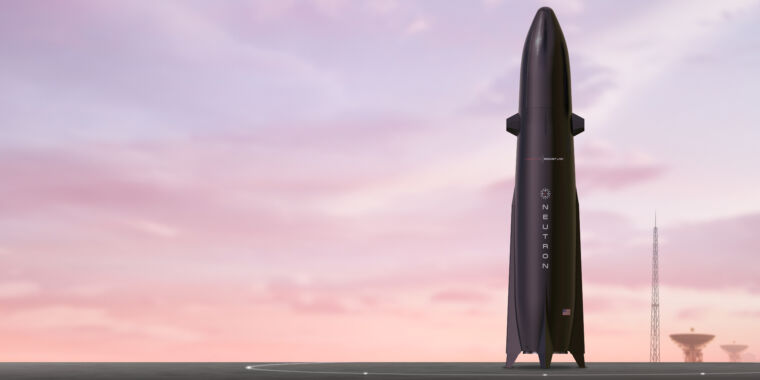-
Rendering of the Neutron rocket on the launch pad.
-
A view of the rocket fairing opening to reveal the second stage and satellite inside.
-
Rocket Lab calls this the “Hungry Hippo” fairing on its Neutron rocket.
Rocket Lab chief executive Peter Beck on Thursday provided an update on the company’s plans to develop a medium-lift rocket, named Neutron.
In a slickly produced video, Beck shared the company’s thinking about how best to develop a reusable rocket that could remain competitive for decades. Neutron, he said, is optimized to serve both for the deployment of megaconstellations as well as geostationary satellites and even interplanetary spacecraft.
“This is what a rocket should look like in 2050,” Beck said. “But we’re building it today.”
In its current conception, Neutron is a fairly stubby rocket, and Beck said this shape was designed both for launch and reentry into Earth’s atmosphere. Rocket Lab intends to use a wider-shaped rocket to catch more atmospheric drag during reentry, requiring less fuel to slow down. The structure will be made of a proprietary carbon fiber for strength and less mass. The first stage will have fixed landing legs, and the rocket will only land back at the launch site rather than offshore. Beck said the costs of marine landings were simply too high, and the goal is to eventually be able to launch a Neutron, land it, and launch again within 24 hours.
The first stage will be powered by seven “Archimedes” rocket engines, which burn methane and liquid oxygen. Beck said the company will go for robustness and reuse with the Archimedes engine, rather than squeezing every ounce of performance out of the machine. The company is developing Archimedes in-house and plans to test fire components of the engine in 2022. The baseline goal is to reuse each first stage 10 times.
“The lightweight structures are absolutely critical for all of this,” Beck told Ars in an interview after his presentation. “If you can take all of the mass out of the structure then you don’t need screaming ISP (specific impulse), and you don’t need screaming engine performance.”
The upper half of the rocket also has some unique characteristics. The second stage will not be reusable, so it will be as light as possible and suspended above the first stage. It will consist only of a single vacuum-optimized Archimedes engine, fuel tanks, and the payload itself.
The payload fairing will open into four separate sections, release the second stage, and then close again before landing back on Earth with the first stage. Although Beck said it was entirely unintentional, the payload fairing looks strikingly like the rocket in the James Bond film You Only Live Twice.
In reusable mode, Neutron is projected to have the capacity to lift 8 metric tons to low Earth orbit and 15 tons in fully expendable mode.
As part of the video, Beck showed steel and aluminum—two popular choices for rocket structures that are also used for SpaceX’s Starship and Falcon 9 vehicles, respectively—being crushed upon impact with a blunt object. Then he showed a carbon composite withstanding the impact.
Composites are lightweight and strong but expensive. However, Beck said the material was essential to make the economics of Neutron’s reuse work and that Rocket Lab would use an automated process of laying down composite structures. “That process is used in industry all over, it’s just never been applied to rockets,” he said. “You can put down meters of tank in minutes. So it’s kind of like 3D printing a rocket, but instead of 3D printing a rocket at millimeters a minute, you’re doing meters a minute.”
Neutron rocket presentation.
As with all rocket developments, there is a fair amount of uncertainty in when a project will be completed, especially one with novel features and lots of in-house development. Earlier this year, Beck said Neutron was on schedule to reach the launch pad in 2024, but he did not mention an initial launch date during Thursday’s online presentation.
During a subsequent interview, Beck said the company’s internal schedules are still pointing toward a 2024 test flight. However, he did not want to put a firm date on a launch, because such public schedules almost invariably slip to the right. “Yeah, I’m just so sick of all of the bullshit in the industry,” he said. “There’s a lot of bullshit in the industry.”
Beck also declined to share a launch price for Neutron customers. The vehicle will be entering a medium-lift market where it must compete with the Falcon 9 rocket, which has about twice the lift capacity and an exceptional track record, as well as the Terran R vehicle, which is under development by Relativity Space and designed for full reusability.
“You don’t go through all of the pain of developing a launch vehicle if you don’t think you’re going to be competitive with what’s currently in the market today, and what’s planned for the future,” he said. “We think we’re going to be highly competitive.”
Listing image by Rocket Lab
